One effect of my cross-country move from the San Francisco bay area to Maryland is that I now have easier access to more types of wood. In particular, I can get southern yellow pine (SYP, also called simply “yellow pine” by actual southerners). Even if the local supplies of it are kind of weird, there are big-box stores carrying it within a 2-hour drive.
Since I finished one substantial laminated-top project (the “auxiliary bench“) with SYP along with a few other utility pieces, I have now used it in addition to a bunch of other woods for workbench construction. I asked some friends back in California if they were interested in my thoughts on SYP now that I’ve had a chance to work on it, and they said, “yeah, why not?”
Because this blog is about woodworking, this discussion is oriented mostly on using this wood (and others) for workbench construction. However, this is by no means its only use.
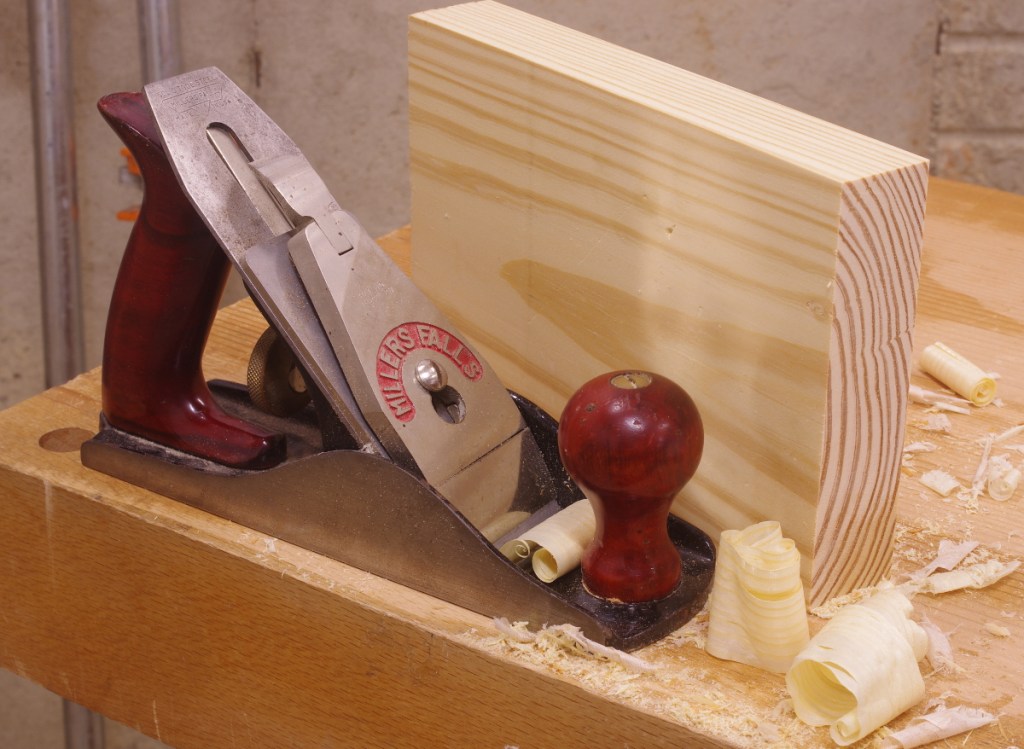
Here’s what I will survey:
- Southern yellow pine
- Douglas-fir (several varieties)
- Beech (F. sylvatica and F. grandifolia work similarly)
- Soft maple
To recap the Chris Schwarz book, you’re not looking for the “perfect” wood when building a workbench. You generally want something that’s reasonably heavy, reasonably stiff, and cheap. That last bit is important because you’ll use a lot of wood on a bench, and you’re also probably going to beat the crap out of it as well, so there’s no use if you get all sentimental about that kind of thing. Workability also helps, especially if you plan to use a lot of hand tools.
Southern Yellow Pine
When Schwarz first started to research workbenches, he was lucky to have a source of cheap wood that he wouldn’t feel bad about consuming and mauling with abandon. Or perhaps we were the lucky ones. Things might be very different for the aspiring benchbuilder if Schwarz had no access to southern yellow pine in his local big-box stores. Even in those retailers, which tend to be overpriced for lumber, this stuff is currently running between 50 and 75 cents per board-foot.
So it’s cheap, it’s stiff, it’s usually pretty heavy, and you can get it in wide, thick sizes. The 2×12 is the go-to size; if the pith runs through it, in clear enough pieces, you can slice that out and have quartersawn stuff as a result. It’s also fine to use narrower stuff like 2x10s if they look good.
Moreover, it’s sold dry (well, mostly dry). This is a requirement: If you don’t kiln-dry yellow pine, the sap/pitch makes for a wretched sticky mess. Even when dried, it’s still possible to run into “pitch pockets” with clumps of goo that hasn’t fully set into resin.

You gotta clear that stuff out. Ick.
So you’re thinking that there’s got to be a catch. There are two principal issues:
- It’s not available in many parts of the country. Well, at least if it’s not pressure-treated.
- You might need to pay attention to the latewood.
At this point, I should mention that there are several different kinds of “southern” yellow pine. The kind that you’re most likely to get commercially is loblolly pine, and that’s what we’ll concentrate on.
So let’s talk about those growth rings. Many woods have a substantial difference between the so-called earlywood (sometimes called springwood) and latewood (summerwood) in their annular rings, but in SYP (and douglas-fir, which we’ll get to soon), it’s dramatic. Simply put, the earlywood is fairly soft and the latewood is dense and tough.
This varies from tree to tree. There’s a lot of detailed information on the factors in publications like Summary on Growth in Relation to Quality of Southern Yellow Pine by B. Paul and D. Smith, 1956, USDA Forest Service, Forest Product Laboratory Report No. 1751. That is fascinating reading to me, but when it comes down to it, it’s best if you get a feel for it in practice.
The factor that you’ll feel the most is the latewood, especially when working with hand tools. In some boards, the latewood will be really tough. You’ll also get a wide variety of early- and latewood quantity per annual ring. This view of the side of the new bench should give you the idea:

The pieces with the smaller annual rings (often with the thinnest latewood sections) were the toughest to deal with. Strangely, the third from the left with the very thick sections of latewood was not too bad.
By “tough to deal with,” there are two difficulties, at least that I noticed. One was simply that when planing or chopping or whatever, the tougher ones tell you when you need to sharpen your blade because it just refuses to work. The other problem is that when ripping, your saw can track the latewood grain. Here’s the offcut from a large tenon cheek where this sort of thing can occur:

The earlywood is generally pleasant to work. It’s not as soft as, say, eastern white pine or that radiata stuff, but it’s not a bear, either. It’ll mush and smash up (for example, when chopping) if your tools aren’t particularly sharp, but it’s not a big deal.
Most softwoods have a higher tendency to “spelch,” that is, splinter out of an end when cutting across the grain. SYP varies across individual pieces, but it’s never really terrible. Though it’s very stiff, the fibers deform pretty evenly. Flattening the new bench (going cross-grain with a jointer plane) was the easiest flattening job that I’ve ever done. It might have helped that the bench was pretty flat to begin with, but it was a smooth, even motion, and the shavings were very uniform.
To give you an idea of what you can expect, I took the smoothing plane shown earlier (and later), and just went at some endgrain with its 45-degree blade angle. Going right off the edge about the worst thing you can do to invite spelching. This is the result; it’s pretty close-up; the piece is about 1/2″ thick:
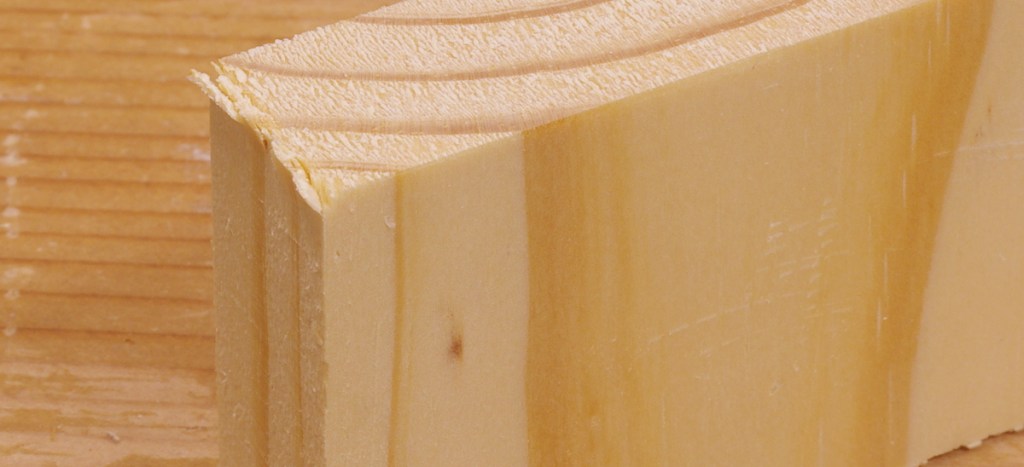
SYP machines really well. Here’s a sub-1mm offcut that I took with the bandsaw; this is actually two pieces glued together:

This was with a pretty aggressive “Wood Slicer” blade.
There is one thing I wonder about yellow pine. Supposedly, the jeffery pine that you see up in the Sierra Nevada is a yellow pine. It gets really big. Could it have properties like this? Not that I have any idea how you’d get any, especially kiln-dried. Maybe someone has an operation up there. Or maybe it would be like (or even sold as) ponderosa pine, as this is also a yellow pine.
Douglas-Fir
Oh, douglas-fir, what a tangled web we weave.
First off, Pseudotsuga menziesii, you are not a fir, and that is why I put the dash in your name. You should probably be called Douglas Weirdofreak, but I suppose that we’d need approval from Pseudotsuga wilsoniana, or whatever that thing is being classified as these days. OK, I digress.
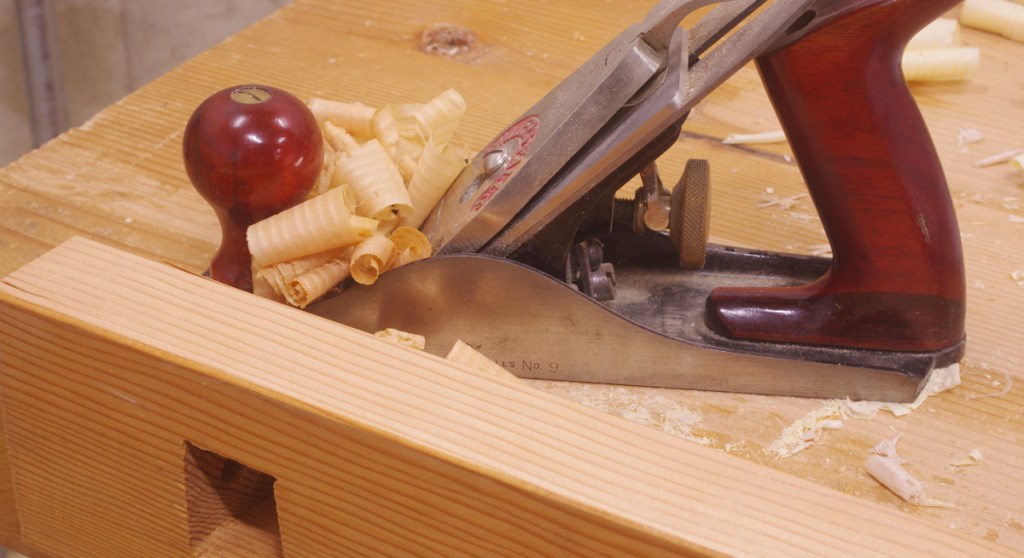
The wood, being very stiff and strong, has many uses, such as wooden boatbuilding, where it can be used for many purposes, including masts. As far as most people are concerned, most of the douglas-fir available for purchase is for construction and framing. This makes it somewhat inexpensive, but it’s still not as cheap as SYP.
And it’s almost invariably sold green. Quite green. For the benchbuilder (and woodworker in general), this is obnoxious for several reasons: It’s going to shrink and move a lot when it dries, so after acquisition, you’re going to have to wait for that to happen, at least a little. It hard to gauge how heavy individual pieces are because they can be sopping wet. The earlywood is even mushier than usual.
Here is a piece of real bottom-of-the-barrel construction-grade douglas-fir, from the 2×4 (stud) pile:
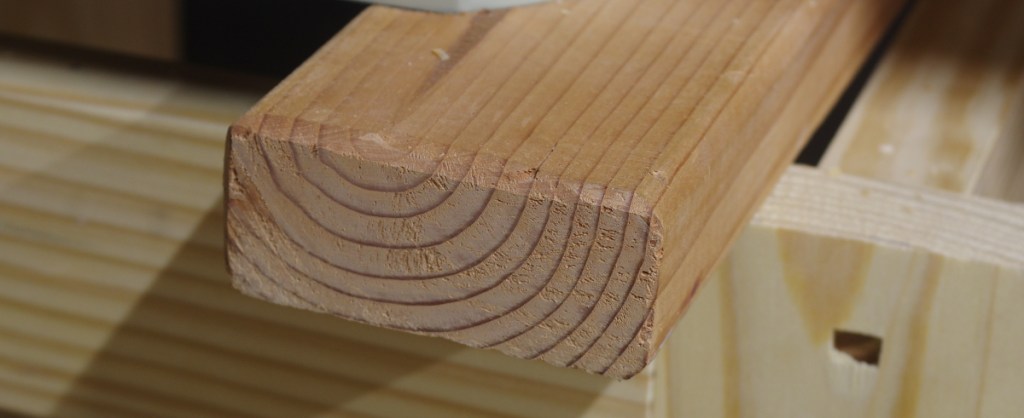
You probably don’t want to build a bench with that kind of stuff. The 2x4s are always from the worst part of the tree. The annular rings are huge. There is a lot of earlywood without much latewood. The good news is that, as is the case with SYP, if you make a foray over to the wide pieces (e.g. 2×12, 2×10), you find better stuff. You’re going to have to be picky, of course. Wilbur Pan built a fantastic Roubo out of 4x4s; he took his time collecting the pieces he needed.
If you’re lucky, you can find another grade of douglas-fir. This is sometimes called “old-growth” (and sometimes it is), and at other times it’s just called “clear.” In the photo below, the three pieces on the left were sold as “clear”. I got them at Minton’s in Mountain View, which has unfortunately been out of business for several years:

The two pieces with the holes in them were stretchers on my very first bench before I replaced them with wider stuff. They came dry and extremely well-dimensioned.
The two pieces on the right may look similar, but they are of much different origin. They were reclaimed from an old warehouse in San Francisco, and came to me by way of Bill K., to whom I’m very grateful. I built the Screwbo out of that stuff, and a friend back out in San Francisco recently completed a cousin bench that he calls the Jacques Roubo from the same source.
But wait–there’s more. What if I told you that there was douglas-fir with even tighter annular rings? Well, get a load of this:

That square sitting on top is metric (a.k.a. “sensible”), and each tick is 1mm. I found this board dumpster diving while a neighbor in SF was renovating. When I pulled it out, it was covered in some sort of contact paper and had been originally used as a shelf. (I’ve been working on making it into some kind of box for years now, but clearly not working terribly hard at it.)
OK, it’s stiff and strong, but will dent, especially while green. So far, on paper, this is pretty similar to SYP. But what happens when you take tools to it?
Mostly, it’s not too bad. Douglas-fir saws pretty well, and planing it works fine, too. If you like to pound nails into stuff, doing that when it’s is green is super easy.
However, there are two properties of this wood that drive people nuts. The first is that it spelches horribly. Observe what happened when I did the same thing on endgrain with the smoothing plane that I did earlier:

All of my woodworking buddies out west know what I mean. Douglas-fir doesn’t just blow out at the ends. The fiber bond fails at a substantial distance from the end, and the wood really wants to follow the shake a long ways down (like being riven). The result is an appalling mess of huge splinters and chunks cracking off of the end. It will do this if you so much as look at it funny. I’m not sure why this is; it might have something to do with how strangely “dry” it feels to the touch. Redwood also pulls this stunt to a certain extent, for whatever that’s worth.
This effect is worst in green wood and gets marginally better as it dries and ages, but it’s still awful. The piece above is 100+ years old. It’s so bad that you have to be extremely cautious even when sawing boards to length–especially with a hand saw. If you don’t take the protective measure of rotating and sawing in from all corners before completing a cut, it’ll snap off badly, invariably in the most ugly way possible.
Still, with this awareness, you can prevent bad splintering, at least until some assclown mover decides to bang the underside edge of your benchtop onto the concrete.
The other thing that I dislike about working douglas-fir is how it has a tendency to wear your tools. Green stuff is OK, but the old stuff is especially cruel to your edges. You just seem to sharpen constantly. I ran into this when using my scrub plane to dimension the pieces of my bench, and that’s not a tool that usually needs a lot of sharpening. Just take a look at what it did to the sole of that plane:

Think twice about taking a woodie to douglas-fir.
It machines OK, just be careful about what kinds of blades (or whatever) you use. I imagine that the carbide-tipped stuff does a lot better against the old stuff.
Overall, this is an extremely versatile wood and should not be discounted when building a bench or in any kind of utility work. It’s very stable when dry, not moving much under different humidity conditions. I wouldn’t think twice about using it for a workbench base even if I were dead-set on a hardwood top. Speaking of which…
Beech
Now I’m going to talk briefly about two other woods that I’ve used in benches. The first is beech, which is pretty traditional for Europeans. It’s moderately hard, fairly heavy, and stiff. As with the softwoods we’ve just talked about, the fiber structure is quite fine, so you’re not likely to get crud caught up in places.
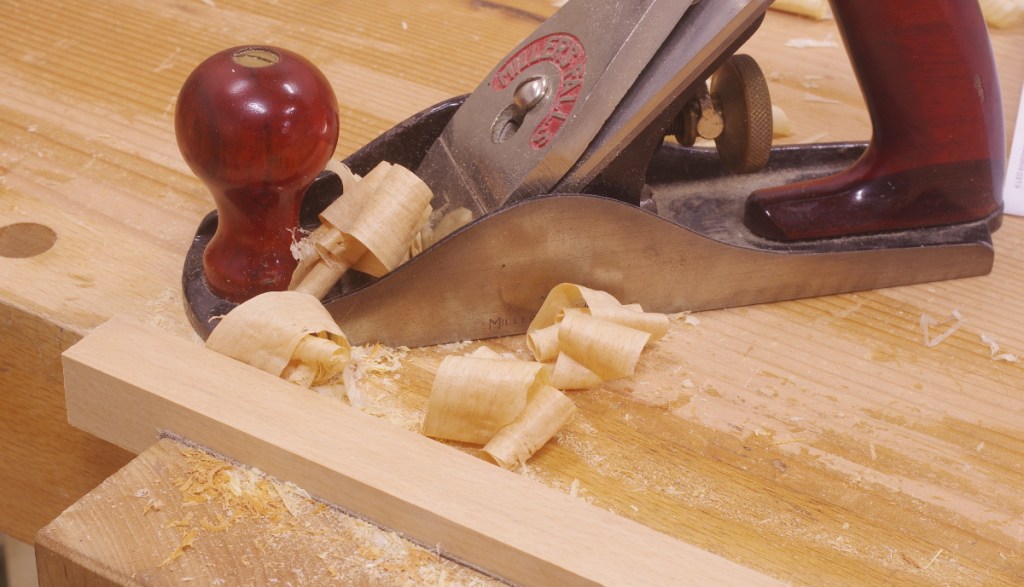
Beech is a go-to utility wood in Europe, where it’s been reasonably well-managed there for a long time. So it’s readily available and inexpensive there, and there’s pretty much no reason not to use it for benchmaking, at least if you’ve got it. The species that grows over here in North America is similar, but it’s rarely harvested, perhaps because we have trees such as the soft maples that are easier to manage. Still, you might find a sawmill that’s sawn one up.
For some unknown reason, beech happens to be one of my favorite woods, and I’m always interested in picking some up. There’s something about the grain that I like, but I can’t really put my finger on it.
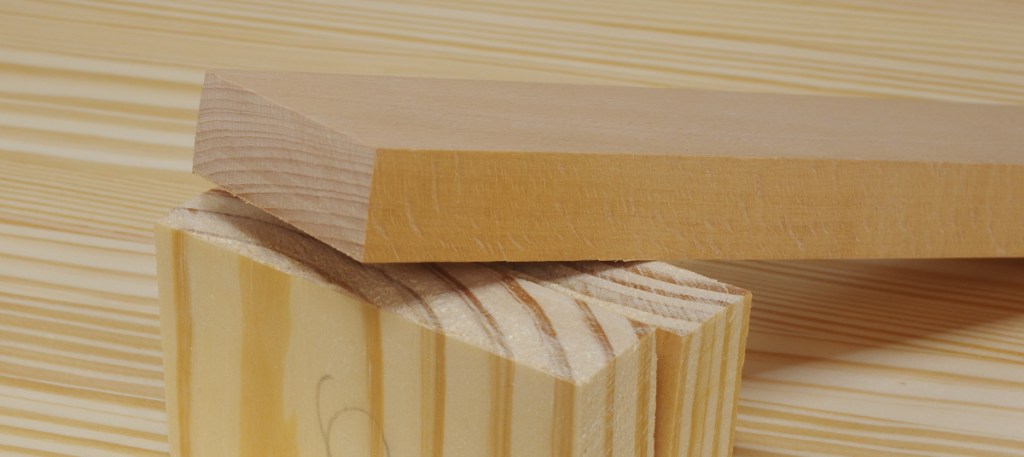
That’s not to say, though, that beech is my favorite wood to work. It’s not too bad, but it will put up more of a fight when planing and chiseling than something like cherry or walnut. I also don’t like it when the grain reverses (sometimes old knots telegraph through in weird ways), but that’s at least rare.
I personally wouldn’t use it for a bench unless I had ready access to a lot of it, at least not entirely. I did use an 8/4 chunk for the very front piece of my benchtop, and that’s been great. The dog holes mostly went in that piece.
It’s really easy to machine.
Soft Maple
The last wood that I’m going to talk about for benchmaking is not an obvious one. When people think of a maple bench, they think of hard maple, because, you know… it’s really hard. When I think of hard maple, I think of a wood that’s a royal pain in the butt because it’s so freakin’ hard. It also isn’t cheap.
Soft maple, on the other hand, can be a joy to work as long as the grain doesn’t be a big ol’ jerk and reverse. It’s usually not as hard as something like beech, but it’s no pushover. And it’s also relatively inexpensive for a hardwood, but keep in mind that you can’t quite compare it to something like SYP in that regard. You’re also more likely to find big cuts of at a sawmill than beech.
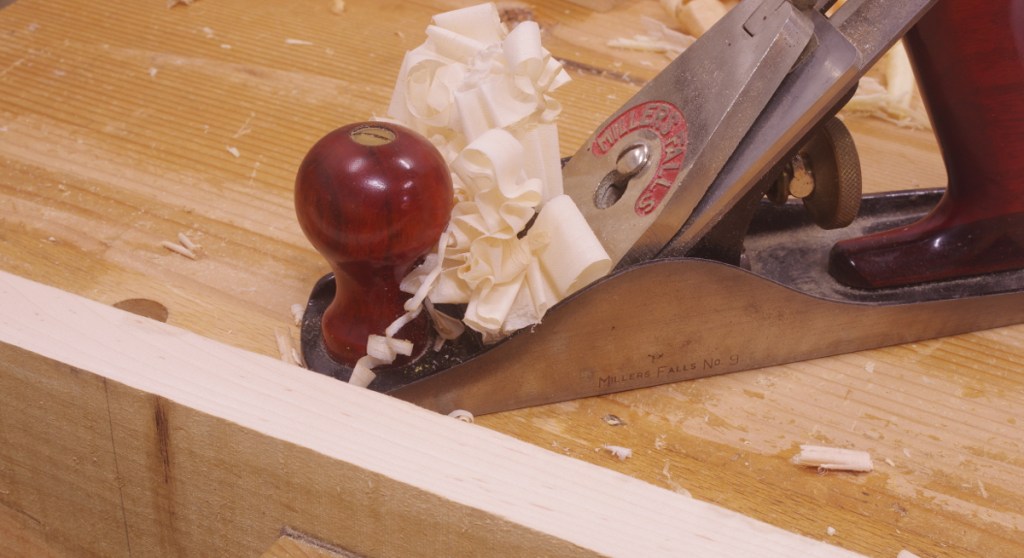
When I was looking for a hardwood to line the front and rear of my auxiliary bench (just like I used beech on the front of the Screwbo), a board of soft maple immediately caught my attention. I’d picked it up at the lumberyard for odd jobs.
Seems legit (so far).
There are lots of other woods I’d like to explore for utility and benchbuilding work. For example, the “hem-fir” stuff that you find as construction lumber is full of intrigue; I have some of this. There just needs to be a reason to try. Perhaps I’ll never need to build another bench (mine has served very well), but there are lots of other things in the shop that need to be built.
